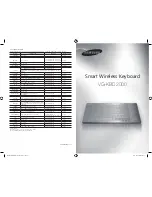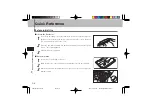
○
○
○
○
○
○
○
○
○
○
○
○
○
○
○
○
○
○
○
○
○
○
Song/Styles 8•1
○
○
○
○
○
○
○
○
○
○
○
○
○
○
○
○
○
○
○
○
○
○
Song/Styles 8•1
instrument’s global parameters at the start and
during the recording, such as effects changes or
Performance selections and tempo changes, etc..
SONG/STYLE PERFORMANCES
A Song/Style is governed by its associated Song/
Style-Performance which determines how it plays
and simplifies Song/Style recording because it
contains all the information necessary to record
without the need to set parameters while record-
ing. When you record a Song/Style, it is best to
programme the associated Song/Style-Perform-
ance beforehand.
A WK3 Song/Style is associated to a single Per-
formance. A
Song/Stylecannot be saved as a
MIDI file.
Programming the Song/Style-Performances
Song-Performances are not accessed from the
Performance Groups, but directly from the PER-
FORMANCE button of the EDIT PERFORM-
ANCE section. A programmed Song/Style-Per-
formance can be copied to all other Song/Styles
in memory.
A general approach to Performance editing is
outlined in chapter 4, “Sounds & Performances”,
page 10. For detailed programming, including
all the parameters of the Performance, MIDI,
Mixer and Sound buttons of the Edit Performance
section, refer to the Edit Performance chapter 13
of the Reference Guide.
An example of how to prepare a Song/Style-Per-
formance before recording a Song/Style is also
outlined in the Song/Style Recording chapter 17
of the Reference Guide.
This chapter discusses Song/Styles from a gen-
eral point of view. How to load Song/Styles into
your WK3 is detailed in the Disk chapter 6, page
10 «Load All», while Song/Style recording is dis-
cussed in the Song/Style Recording chapter of
the Reference Guide.
WHAT IS A SONG/STYLE
A Song/Style is an 8-track Song created by re-
cording existing Styles (Rom or User) with the
keyboard tracks (Upper 1, Upper 2, Lower).
Song/Styles capture the chords that trigger the
Style accompaniment patterns on a “Chords
track” and you can choose to record one or more
keyboard tracks according to your requirements.
During the recording, you can exploit the Intro,
Fill and Ending patterns and change Style at will.
In practice, what you normally do in real time with
a Style is captured by the sequencer in Song/
Style Record mode to create a Song/Style.
Up to 8 tracks are engaged by the Sequencer to
record a Song/Style: 5 associated to the accom-
paniment patterns and 3 to the keyboard tracks.
Song/Styles can be loaded from disk in WK3 for-
mat only, or recorded using the Song/Style Re-
cording method.
In many other respects, a Song/Style is similar
to a Song. Song/Styles, however, do not contain
a Lyrics track.
The on-board Sequencer features several edit-
ing functions which allow you to modify a recorded
Song/Style by copying or cancelling parts and cor-
recting timing errors.
A “ghost track”, called the Master
Track, records
all general control messages which define the
• 8 Song/Styles
instrument’s global parameters at the start and
during the recording, such as effects changes or
Performance selections and tempo changes, etc..
SONG/STYLE PERFORMANCES
A Song/Style is governed by its associated Song/
Style-Performance which determines how it plays
and simplifies Song/Style recording because it
contains all the information necessary to record
without the need to set parameters while record-
ing. When you record a Song/Style, it is best to
programme the associated Song/Style-Perform-
ance beforehand.
A WK3 Song/Style is associated to a single Per-
formance. A Song/Stylecannot be saved as a
MIDI file.
Programming the Song/Style-Performances
Song-Performances are not accessed from the
Performance Groups, but directly from the PER-
FORMANCE button of the EDIT PERFORM-
ANCE section. A programmed Song/Style-Per-
formance can be copied to all other Song/Styles
in memory.
A general approach to Performance editing is
outlined in chapter 4, “Sounds & Performances”,
page 10. For detailed programming, including
all the parameters of the Performance, MIDI,
Mixer and Sound buttons of the Edit Performance
section, refer to the Edit Performance chapter 13
of the Reference Guide.
An example of how to prepare a Song/Style-Per-
formance before recording a Song/Style is also
outlined in the Song/Style Recording chapter 17
of the Reference Guide.
This chapter discusses Song/Styles from a gen-
eral point of view. How to load Song/Styles into
your WK3 is detailed in the Disk chapter 6, page
10 «Load All», while Song/Style recording is dis-
cussed in the Song/Style Recording chapter of
the Reference Guide.
WHAT IS A SONG/STYLE
A Song/Style is an 8-track Song created by re-
cording existing Styles (Rom or User) with the
keyboard tracks (Upper 1, Upper 2, Lower).
Song/Styles capture the chords that trigger the
Style accompaniment patterns on a “Chords
track” and you can choose to record one or more
keyboard tracks according to your requirements.
During the recording, you can exploit the Intro,
Fill and Ending patterns and change Style at will.
In practice, what you normally do in real time with
a Style is captured by the sequencer in Song/
Style Record mode to create a Song/Style.
Up to 8 tracks are engaged by the Sequencer to
record a Song/Style: 5 associated to the accom-
paniment patterns and 3 to the keyboard tracks.
Song/Styles can be loaded from disk in WK3 for-
mat only, or recorded using the Song/Style Re-
cording method.
In many other respects, a Song/Style is similar
to a Song. Song/Styles, however, do not contain
a Lyrics track.
The on-board Sequencer features several edit-
ing functions which allow you to modify a recorded
Song/Style by copying or cancelling parts and cor-
recting timing errors.
A “ghost track”, called the Master Track, records
all general control messages which define the
• 8 Song/Styles
Summary of Contents for WK3 World Keyboard
Page 1: ......
Page 2: ......
Page 3: ......
Page 5: ......
Page 7: ......
Page 9: ......
Page 11: ......
Page 13: ......
Page 14: ... vi Introduction v ...
Page 15: ......
Page 17: ......
Page 19: ......
Page 21: ......
Page 23: ......
Page 25: ......
Page 27: ......
Page 29: ......
Page 31: ......
Page 33: ......
Page 35: ......
Page 37: ......
Page 39: ......
Page 41: ......
Page 43: ......
Page 45: ......
Page 47: ......
Page 49: ......
Page 51: ......
Page 53: ......
Page 55: ......
Page 57: ......
Page 59: ......
Page 61: ......
Page 63: ......
Page 65: ......
Page 67: ......
Page 69: ......
Page 71: ......
Page 73: ......
Page 75: ......
Page 77: ......
Page 79: ......
Page 81: ......
Page 83: ......
Page 85: ......
Page 87: ......
Page 89: ......
Page 91: ......
Page 93: ......
Page 95: ......
Page 97: ......
Page 99: ......
Page 101: ......
Page 103: ......
Page 105: ......
Page 107: ......
Page 109: ......
Page 111: ......
Page 113: ......
Page 115: ......
Page 117: ......
Page 119: ......
Page 121: ......
Page 123: ......
Page 125: ......
Page 127: ......
Page 129: ......
Page 131: ......
Page 133: ......
Page 135: ......
Page 137: ......
Page 139: ......
Page 141: ......
Page 143: ......
Page 145: ......
Page 147: ......
Page 149: ......
Page 151: ......
Page 152: ... 8 8 User Guide 8 ...
Page 153: ......
Page 155: ......
Page 157: ......
Page 159: ......
Page 161: ......
Page 163: ......
Page 165: ......
Page 167: ......
Page 169: ......
Page 171: ......
Page 173: ......
Page 175: ......
Page 177: ......
Page 178: ... Reference Guide ...
Page 179: ......
Page 181: ......
Page 183: ......
Page 185: ......
Page 186: ... 12 8 Reference Guide 1 ...
Page 187: ......
Page 189: ......
Page 191: ......
Page 193: ......
Page 195: ......
Page 197: ......
Page 199: ......
Page 201: ......
Page 203: ......
Page 205: ......
Page 207: ......
Page 209: ......
Page 211: ......
Page 213: ......
Page 215: ......
Page 217: ......
Page 219: ......
Page 221: ......
Page 223: ......
Page 225: ......
Page 227: ......
Page 229: ......
Page 231: ......
Page 232: ... 14 10 Reference Guide 1 ...
Page 233: ......
Page 235: ......
Page 237: ......
Page 239: ......
Page 241: ......
Page 243: ......
Page 245: ......
Page 247: ......
Page 249: ......
Page 250: ... 16 12 Reference Guide 1 ...
Page 251: ......
Page 253: ......
Page 255: ......
Page 257: ......
Page 259: ......
Page 261: ......
Page 263: ......
Page 265: ......
Page 267: ......
Page 269: ......
Page 271: ......
Page 273: ......
Page 275: ......
Page 277: ......
Page 279: ......
Page 281: ......
Page 283: ......
Page 285: ......
Page 287: ......
Page 289: ......
Page 291: ......
Page 293: ......
Page 295: ......
Page 296: ...Appendix ...
Page 297: ......
Page 299: ......
Page 301: ......
Page 303: ......
Page 305: ......
Page 307: ......
Page 309: ......
Page 311: ......
Page 313: ......
Page 315: ......
Page 317: ......
Page 319: ......
















































